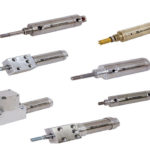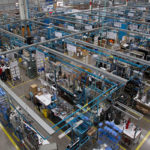Norgren pneumatics expert Dietmar Grün provides a thorough introduction to pneumatic systems, addressing application areas, core components, the critical role of pneumatic air preparation and treatment products and pneumatic actuators and key considerations for selecting pneumatic actuators.
Contributed by Dietmar Grün, Product Manager, Motion Control, Actuator, Norgren
Pneumatic systems harness the energy generated by the controlled release of compressed air to power and move tools and machinery used in the engineering, manufacturing, construction, medical and amusement industries and are especially prevalent in industrial automation and food, beverage and pharmaceutical manufacturing applications. Pneumatic systems use air compressors to reduce the volume of air in the system, which increase its pressure, and then pass that pressurized air through one or more filters and lengths of pneumatic tubing, where it’s controlled by valves, until it reaches a pneumatic actuator (also known as a pneumatic cylinder), which produces the linear or rotary motion and force required to power the end process, such as a pushing, lifting, gripping, punching or vacuum device.

Pneumatic actuators provide alternatives to electric actuators and motors and are typically used to power devices that handle relatively small, lightweight loads since pneumatic systems produce less force than hydraulic systems. But that doesn’t make them any less vital to the many industries they’re employed in. In fact, due to a combination of the relatively low cost required to maintain pneumatic systems and engineering advancements including corrosion-resistant seals that help prevent leaks, the application range for pneumatic systems is now comparable to that of the electric automated systems also used to handle smaller loads.
Pneumatic system applications
Pneumatic systems are employed in a variety of markets, including energy applications spanning oil and gas refinement to power generation, food, beverage and pharmaceutical manufacturing applications ranging from blow molding to process automation and packaging and industrial automation applications including packaging and material handling equipment, such as pick and place systems, which use clamps, grippers and vacuum cups to move, sort and stack delicate parts like electronic components or to hold parts in position while other work, like cutting or crimping, is carried out.

They are also widely used in industrial applications including paint and coating sprayers, transportation applications including railway door control and suspension systems, commercial vehicle applications spanning cabins, chassis and engines, medical applications ranging from pressure cuff devices to infusion pumps, surgical drills, ventilators and medical beds and construction equipment including power tools such as jackhammers, which channel compressed air through a pipe to pump a metal chisel into the pavement.
Pneumatic components
The key components of pneumatic systems include:
- Air compressors and pumps, which provide a continuous flow of compressed air at the required pressure.
- Air preparation and treatment products, which deliver the high-quality compressed air required to carry out work and ensure efficient operation.
- Vacuum generators and ejectors, which quickly generate the level of vacuum needed to handle objects, have short cycle times and are generally used in conjunction with vacuum accessories including vacuum pad assemblies.
- Instrumentation including pressure and vacuum switches, which both sense pressure changes and respectively detect mechanical force and regulate the vacuum flow between two spaces, and pressure and vacuum gauges, which provide the constant monitoring and measurement necessary to ensure efficient operation.
- Tubing, which is used to move pressurized air through pneumatic systems, tube fittings, which are used to connect tubing to other elements of the system and maintain a continuous flow of power to the system’s end process, and fitting accessories like panel mounts, cable grips and conduit.
- Valves, which are used to control the pressure, volume and direction of pressurized air as it flows through the system.
- Mufflers and silencers, which are a straightforward and cost-effective way to safely vent pressurized air into the atmosphere to reduce the excessive noise generated by pneumatic air exiting an exhaust.
- Pneumatic actuators, which are used to generate the linear or rotary motion and force required to move a piston and power the end process, such as a pushing, lifting, gripping, punching or vacuum device, and actuator accessories including spool assemblies and piston seal kits.

Amongst the most critical of these components are the air preparation and treatment products, which include the pneumatic filters, pneumatic lubricators, pneumatic regulators, air filter regulators, air dryers and drains, air pressure boosters and related accessories that deliver the high-quality compressed air required to carry out work and ensure efficient operation, and the pneumatic actuators that do the work.
Pneumatic air preparation and treatment products
Pneumatic filtering components are designed to remove moisture, dust particles and oils from the compressed air supply to prevent contaminants from congealing on or corroding components such as valves and seals. Solutions include pneumatic filters, compressed air dryers that dehumidify industrial process air and aftercoolers (also known as heat exchangers) that cool compressed air to precipitate and drain the water that would otherwise condensate in the pipe system.
Pneumatic regulators are designed to optimize the pressure generated by the air compressor since excess pressure can reduce component lifespans, waste energy and increase operating costs. High pressure in a small area can do the same work as lower pressure in a larger area, but air regulators don’t precisely control airflow, just air pressure. So, they’re used in combination with flow control valves, which work by restricting the ports through which air can flow at a given temperature over a given period of time, to make pneumatic systems operate at the lower end of their required pressure range in order to conserve energy, save money and prolong the life expectancy of the system.
In addition, several pneumatic suppliers offer air filter regulators, which combine air filters and regulators in a single device. Air filter regulators remove water and particulate matter from compressed air streams, just like standard air filters, but they don’t remove oil vapors or chemical contaminants. So, they must still be combined with other filtering components to achieve the high-quality compressed air required for efficient pneumatic operation.
Pneumatic actuators
Pneumatic actuators, also known as pneumatic cylinders, are the business end of a pneumatics system. When compressed air is forced into an actuator, it moves the piston housed within it and generates the linear or rotary motion and force required for the end device attached to the piston — such as a pushing, lifting, gripping, punching or vacuum mechanism — to do its work. Pneumatic actuators are lightweight, require little maintenance, can be used in challenging environments exposed to extreme temperatures and corrosive materials and are widely available in National Fluid Power Association (NFPA-) and ISO-compliant models for international compatibility. Their bore, or their inner diameter, determines their output force, and the larger the bore, the greater the force. They do produce less force and operate at slower speeds than hydraulic or electric actuators, but they remain a popular, cost-effective alternative to those technologies in myriad industrial, transportation, commercial vehicle, medical and construction applications.

The key components of a pneumatic actuator include an end cap, a piston, a piston rod, a cylinder barrel, a wiper seal and a cushion sleeve and seal. In a simple circuit, a single-acting pneumatic actuator can be operated by a button. When the button is pressed, the compressed air moves the piston rod outward to generate the required linear or rotary motion and force needed to operate the end device, like an arm that moves a load along a linear path, a gripper that picks and places a component or a vacuum cup used to handle glass.
Types of pneumatic actuators
There are several different types of single- and double-acting pneumatic actuators engineered to suit many different types of applications.
Single-acting pneumatic actuators have a single air-entry port and push the piston in a single direction. The piston is returned to its original position by a spring. Single-acting pneumatic actuators have a limited stroke length, which makes them ideally suited for slower moving operations, and they use less air than double-acting actuators, which helps increase efficiency and reduce operating costs.
Double-acting pneumatic actuators have two air-entry ports, which enables them to execute both an instroke and an outstroke and move the piston back and forth without the use of a spring.
Tie-rod actuators are the most prevalent actuator design in the pneumatics industry and are widely used in heavy-duty and high-temperature industrial automation applications. They have square or rectangular end caps that are secured to the barrel by threaded tie rods and nuts, are equipped with static seals to prevent air leakage and are available in standard, compact and lightweight variations. They are also available with profile barrels, which feature concealed tie rods, enable direct assembly for flush-mounted switches and offer a cleaner appearance, and round barrels, which feature exposed tie rods, are available in a wide variety of configuration and mounting options and can easily be adapted to solve difficult actuation challenges.

Welded actuators are lighter and more compact than the standard tie-rod configuration and, as such, are widely used in lighter duty and lower force applications including mobile equipment. Instead of tie rods, these pneumatic actuators feature barrels welded directly to the end caps and ports welded to the barrel. Their front rod glands are generally bolted or threaded into the cylinder barrel to allow the piston rod assembly and rod seals to be removed for service and they typically come with fixed or buffer cushions, although some models offer adjustable cushioning upgrades.
Compact actuators are designed for applications where space it at a premium and are available in a variety of options. Norgren, for example, offers compact pneumatic tie-rod, welded and clamp actuators.
Clamp actuators are used to hold a workpiece in place while work is being done. They combine a standard pneumatic actuator with a clamp and a toggle mechanism and are often designed to exhibit robust resistance to weld splatter to ensure long lifetime performance.

Valve actuators generate linear or rotary motion to open and close valves. These pneumatic actuators are compatible with a variety of valves, including ball and butterfly valves.
Rotary actuators produce a reciprocating angular or turning motion that enables an oscillating stoke motion through a defined angle. These pneumatic actuators are available in rack and pinion, rotary vane and helical options, feature simple, durable designs that reduce maintenance requirements and typically deliver relatively high force (torque) for their size. Rotary vane actuators are small, self-contained, double-acting actuators that take up less space than rack and pinion actuators but deliver lower torque. Rack and pinion actuators offer greater torque but can require a larger footprint to achieve certain angular motions.

Rodless actuators, unlike other pneumatic actuators, don’t have a piston rod that extends outside of the cylinder body. Instead, these pneumatic actuators contain the movement they produce within the length of their cylinder body, which, also unlike piston rod cylinders, allows them to support the load during movement.

Key considerations for pneumatic actuators
There are several key considerations that can help you choose the right type of pneumatic actuator with the right physical and electrical characteristics for your unique application.
- Type of motion: Pneumatic actuators can generate linear or rotary motion.
- Single-acting or double-acting:Pneumatic actuators come in single-acting, spring-return and double-acting, pneumatic-return variations and selections will depend on the amount of force and accuracy required, as well as the size of the job. For more information, read Norgren’s “Why Choose a Single-Acting Cylinder” selection guide.
- Pressure and flow requirements: Remember, the larger the cylinder bore, the greater the force. Pneumatic actuators are widely available with bore sizes extending from 8 to 320 mm.
- Operating environment: Several manufacturers offer pneumatic actuators designed to deliver robust, long-lifetime performance in environments exposed to hazards including extreme temperatures, corrosive materials and dirt and dust.
- Special features: If you’re looking to save energy, ensure that the actuator is right-sized and appropriate for the operation at hand and consider using an IVAC product.
Allied Electronics
www.alliedelec.com
Norgren
www.norgren.com






Leave a Reply